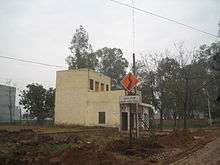Bharat Nirman
Bharat Nirman is an Indian business plan for creating basic rural infrastructure. It comprises projects on irrigation, roads (Pradhan Mantri Gram Sadak Yojana), housing (Pradhan Mantri Awaas Yojana), water supply (National Rural Drinking Water Programme), electrification (Rajiv Gandhi Grameen Vidyutikaran Yojana) and telecommunication connectivity.
| Bharat Nirman | |
|---|---|
| Country | India |
| Prime Minister(s) | Narendra Modi |
Objectives
Bharat Nirman is a business plan for rural infrastructure which was implemented by the Government of India in order to provide some basic amenities to the rural India.[1]
Water Supply
Bharat Nirman was launched by the Government of India in 2005. Providing rural areas with safe drinking water facilities was one of the key objectives of the plan. It got implemented during 2005-06 to 2008-09 . The plan aimed to cover 55,067 un-covered and 3.31 lakh under developed areas with safe drinking water facilities. It also aimed to improve the quality standard of drinking water of 2.17 lakh areas which had poor quality water supplies.[2]

Pradhan Mantri Gram Sadak Yojana
The Pradhan Mantri Gram Sadak Yojana (PMGSY) was launched on 25 December 2000. The primary objective of PMGSY is to provide good quality all-weather roads in all the rural areas where urban-rural road connectivity is found to be very weak.[3] All unconnected habitations with a population of more than 500 persons has been provided connectivity by 2007.[4]
Housing
The main objective is to provide housing facilities to the rural areas of India. According to the plan the government of India will construct 60 lac houses for the rural areas by 2009. The scheme under this is named as Indira Awaas Yojana and is governed by the Ministry of Rural Development. It is mainly sponsored by the central government. The ratio of the sponsorship between the center and the state is 75:25.[5]
Telecom
This plan aims to supply telecommunication facilities to remote areas of rural areas. It aims in increasing the rural telecommunication facilities by 40%. It also aims to supply broadband and Bharat Nirman Seva Kendras in 2.5 lac Panchayats. According to this plan the government of India will connect each and every village by telecommunication facilities. The plan is taken care of by the Department of Telecom which fall under the Ministry of Communication and Information Technology. There are 66,822 villages which are still left to be covered.[6]
Rural Teledensity (for the month of February 2011)
| SL.No. | Circle/State | Percentage of Rural Teledensity as of 31 March 2009 | Percentage of Rural Teledensity as of 28 February 2011 |
|---|---|---|---|
| 1 | Andaman and Nicobar Islands | 16.57 | 31.75% |
| 2 | Andhra Pradesh | 15.22 | 33.19% |
| 3 | Assam | 9.36 | 23.36% |
| 4 | Bihar | 9.17 | 26.41% |
| 5 | Chhattisgarh | 1.81 | 2.77% |
| 6 | Gujarat | 25.21 | 45.81% |
| 7 | Haryana | 28.10 | 51.36% |
| 8 | Himachal Pradesh | 40.47 | 68.68% |
| 9 | Jammu and Kashmir | 16.72 | 29.13% |
| 10 | Jharkhand | 1.44 | 2.35% |
| 11 | Karnataka | 14.36 | 34.26% |
| 12 | Kerala | 35.43 | 52.65% |
| 13 | Madhya Pradesh | 11.07 | 28.95% |
| 14 | Maharashtra (including Goa) | 21.70 | 45.25% |
| 15 | NORTH-EAST- I (comprising Meghalaya, Mizoram and Tripura) | 14.67 | 50.34% |
| 16 | NORTH-EAST- II (comprising Arunachal Pradesh, Manipur and Nagaland) | 3.69 | 7.78% |
| 17 | Odisha | 12.55 | 28.07% |
| 18 | Punjab | 33.11 | 55.45% |
| 19 | Rajasthan | 16.71 | 38.14% |
| 20 | Tamil Nadu | 25.62 | 47.53% |
| 21 | Uttarakhand | 6.04 | 9.46% |
| 22 | Uttar Pradesh | 10.24 | 26.47% |
| 23 | West Bengal (including Sikkim) | 13.50 | 35.22% |
| 24 | Kolkata | - | - |
| 25 | Chennai | - | - |
| 26 | Delhi | - | - |
| 27 | Mumbai | - | - |
| ALL- INDIA | 15.11 | 32.99% |
References
- Bharat Nirman, India.gov.in Archive
- BHARAT NIRMAN - WATER SUPPLY, archived from the original on 6 September 2011
- Pradhan Mantri Gram Sadak Yojna http://www.india.gov.in/sectors/rural/pradhan_manthri.php
- http://rural.nic.in/annual0203/chap-3.pdf
- "housing". Archived from the original on 28 October 2011.
- "telephone". Archived from the original on 20 October 2011.
- "table 1". Archived from the original on 20 October 2011.